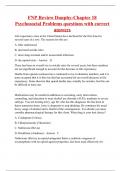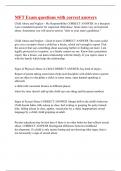FNP Review Dunphy-Chapter 18
Psychosocial Problems questions with correct
answers
Life expectancy rates in the United States have declined for the first time for several years in a row. The reasons for this are
A. little understood
B. increased suicide rates
C. more drug-resistant and/or nosocomial infections
D. the opioid crisis - Answer D
There has been an overall rise in suicide rates for several years, but these numbers are not significant enough to account for the decrease in life expectancy.
Deaths from opioid overdoses have continued to rise in dramatic numbers, and it is
more accepted that it is this rise that has accounted for an overall decrease in life expectancy. Some theorize that opioid deaths may actually be suicides, but this can
be difficult to tease out.
Medications may be needed in additions to screening, early intervention, counseling, and education to treat alcohol use disorder (AUD), moderate to severe subtype. You are treating Jerry, age 60, who has this diagnosis. He has been in detox numerous times. Jerry is desperate to stop drinking. He continues his usual heavy usage of alcohol and is fearful of the consequences. You decide you must consider pharmacological therapy for this client. What drug is your best choice?
A. Citalopram (Celexa)
B. Chlorpromazine (Thorazine)
C. Naltrexone (Revia)
D. Disulfiram (Antabuse) - Answer C
Naltrexone (Revia), an opioid antagonist thatis a synthetic congener of oxymorphone with no opioid agonist properties, has been used effectively for treatment of AUD in combination with non- pharmacological treatment. It can be started when a patient is still drinking alcohol. Naltrexone usein randomized trials demonstrated lower relapse rates, fewer days drinking, and a decrease in crav- ing for alcohol.
There are well-validated screening instru- ments to assist in diagnosing psychosocial problems, as well as tracking progress with treatment. Your patient Gloria, age 29, presents with symptoms of restlessness and anxiety. You decide to have Gloria fill in the following screening instrument.
A. GAD-7 B. PHQ-9
C. CAGE screening exam
D. Life event checklist (LEC) - Answer A
The generalized anxiety disorder seven-item (GAD-7) scale should be used to screen for GAD in primary care. It has been found to have acceptable reliability and criterion, construct, factorial, and procedural validity. The GAD-7 is sensitive to change and can be used to monitor symptom severity over time.
You are seeing Anthony, age 48, for a new patient visit. He tells you "My biggest problemis trying to deal with a divorce. I didn't want a divorce. I still do not want a
divorce. But my wife is leaving!" Your best response is
A. "I'm so sorry. No wonder you are upset." B. "Can you tell me about it?"
C. "You must be devastated."
D. "Sounds like it has been a difficult time." - Answer D
The statement "Sounds like it has been a difficult time" is the most open-ended response, and most likely to encourage more sharing by the client. It is also the most empathic response. The receptionist in your office calls you into the waiting area. In the area is a new client, pacing, with clenched fists, and a flushed face. He is swearing and yelling. What phase of the aggression cycle is he in?
A. Anger
B. Triggering
C. Escalation D. Crisis - Answer C
In the escalation phase of this cycle, interventions include taking control of the situation but speaking calmly and nonthreateningly. Convey empathy. Direct the client to take a time out. Listen. Invite him to a quiet room. Offer medication.
Aaron, age 10, is brought in to see you, his primary care provider, because he is suffering from enuresis. Your treatment plan includes behavioral modification, positive reinforcement, and the follow- ing medication:
A. risperidone (Risperdal). B. imipramine (Tofranil).
C. olanzapine (Zyprexa).
D. methylphenidate (Ritalin). - Answer B
There is no cure for bedwetting, but imipramine (Tofranil) may be used to treat enuresis in children ages 6 to 12. Desmopressin acetate (DDAVP), a synthetic form of the hormone vasopressin that decreases the amount of urine produced by the kidney, is also used for treatment of enuresis.
You suspect that Mr. Blum, age 69, has major depression. In deciding on what antidepressant to start Mr. Blum on after validating that his symptoms meet the diagnostic criteria for major depression, you know you must consider the following.
A. SSRIs are always the best place to start.
B. You must consider a variety of factors, such as side effect profile, safety profile,
as well as patient preferences, to name just a few. C. It will take at least 4 weeks to see improvement after beginning an SSRI.
D. Antidepressants will not be effective unless combined with some form of psychotherapy. - Answer B
Although there is good evidence that an SSRI may be an effective way to treat an episode of major depression, there are always a variety of factors to consider in any
treatment decision.
You are working with Janey, age 18, who suffers from bulimia. You encourage her
to use the technique of self-monitoring. This involves which of the following?
A. Ask the client to make out daily meal plans for 1 week.
B. Ask the client to write about all feelings and experiences related to food.
C. Teach the client about nutritional content and calories of various foods.
D. Encourage the client to ignore feelings and impulses related to food. - Answer B
The binging and purging of bulimia often occur when the person is in a "mindless" state. It is important that the person begin to get in touch with his or her feelings and experiences related to food.
You have put Joe, age 33, on clozapine (Clozaril). Before starting this drug, Joe needs to understand
A. the dietary restrictions.
B. that he must have his blood drawn to monitor his white blood count.
C. that he must avoid the sun.
D. he needs to start an exercise routine. - Answer B
Clozapine (Clozaril) is used to treat certain mental/ mood disorders (schizophrenia,
schizoaffective disorders). Clozapine is a psychiatric medication (antipsychotic type) that works by helping to restore the balance of certain natural substances (neuro- transmitters) in the brain. Clozapine decreases hal- lucinations and helps prevent suicide in people who are likely to try to harm themselves. It enables posi- tive thinking and decreases nervousness. Clozapine treatment has caused severe





